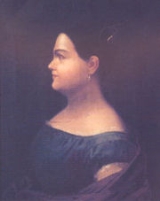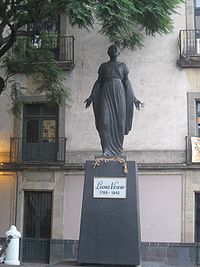
Leona Vicario
Encyclopedia

Mexican War of Independence
The Mexican War of Independence was an armed conflict between the people of Mexico and the Spanish colonial authorities which started on 16 September 1810. The movement, which became known as the Mexican War of Independence, was led by Mexican-born Spaniards, Mestizos and Amerindians who sought...
. From her residence in Mexico City
Mexico City
Mexico City is the Federal District , capital of Mexico and seat of the federal powers of the Mexican Union. It is a federal entity within Mexico which is not part of any one of the 31 Mexican states but belongs to the federation as a whole...
, she was able to provide intelligence
Intelligence (information gathering)
Intelligence assessment is the development of forecasts of behaviour or recommended courses of action to the leadership of an organization, based on a wide range of available information sources both overt and covert. Assessments are developed in response to requirements declared by the leadership...
and money to the rebel movement.
She married fellow insurgent Andrés Quintana Roo
Andrés Quintana Roo
Andrés Quintana Roo was a Mexican liberal politician and author. He was one of the most influential men in the War of Independence and served as a member of the Congress of Chilpancingo...
. They are buried together in the Independence Column
El Ángel
El Ángel de la Independencia , most commonly known by theshortened name El Ángel and officially known as Columna de la Independencia, is a victory column located on a roundabout over Paseo de la Reforma in downtown Mexico City.El Ángel was built to commemorate the centennial of the beginning of...
in Mexico City. Leona Vicario was named by a special commission ordered by then President Antonio Lopez de Santa Anna as the "Sweet Mother of the Fatherland" (Benemerita y Dulcisima Madre de la Patria) in August 1842 only days after her death, she was buried in Mexico City and is the only civilian woman to have received a State Funeral. In February 2010, seven months before Mexico celebrates its 200 years of independence, Mexican writer Carlos Pascual published the novel "La Insurgenta" and by a mix of historical facts and fictional event he tells the story of Leona Vicario as well as the story of many others who participated in the war for and against Mexican independence from the Spanish Empire.

She was arrested in 1813 for participating in the insurgency. When she was discovered, Leona was sent to prison and all of her belongings were confiscated. She was later freed by the insurgents and escaped to Michoacan to meet Andrés Quintana Roo, who later became her husband. In 1818, she was jailed again but received a pardon with the condition that she abandoned the movement. Vicario and her husband were under vigilance until the independence movement succeeded in 1821.

